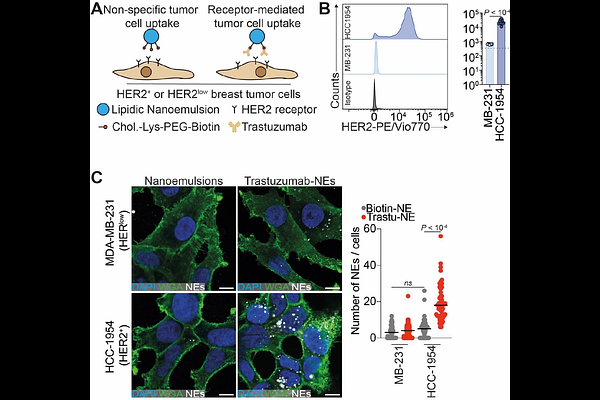Functionalization of lipid nanoemulsions with humanized antibodies using plug-and-play cholesterol anchor for targeting cancer cells

Functionalization of lipid nanoemulsions with humanized antibodies using plug-and-play cholesterol anchor for targeting cancer cells
Boide-Trujillo, V. J.; Mittelheisser, V.; Liu, F.; Lefebvre, O.; Andreiuk, B.; Anton, N.; Goetz, J. G.; Klymchenko, A. S.
AbstractLipid NEs are promising green nanocarriers for diagnostic and therapeutic applications, but their functionalization with biomolecules, such as antibodies, remains a challenge due to liquid nature of their core. Here, we developed an original plug-and-play strategy to graft an antibody (trastuzumab) at the surface of NEs, using components generally recognized as safe (GRAS). We synthesized a reactive derivative of cholesterol and a Biotin-PEG3000-Lysine linker, which can react within one-pot formulation to form an amphiphilic carbamate Biotin-PEG3000-Cholesterol. The cholesterol ensures anchorage of the linker, which effectively exposes biotin moiety at the surface of NEs for further antibody grafting using a biotin-neutravidin coupling. The reaction between the Biotin-PEG3000-Lysine linker and NPC-Chol was confirmed by 1H-NMR and absorption spectroscopy. The obtained biotinylated 50-nm NEs loaded with a near-infrared dye were successfully targeted to neutravidin-coated glass surfaces and imaged at the single-droplet level. The biotinylated NEs bearing the trastuzumab antibody targeted specifically HER2-amplified breast cancer models HCC-1954 and SKBR3, in contrast to control MDA-MB-231 (HER2-low) cells. Altogether, our study proposes an efficient methodology for grafting antibodies to the surface of NEs, which offers new opportunities of application of these green nanocarriers in biomedicine.